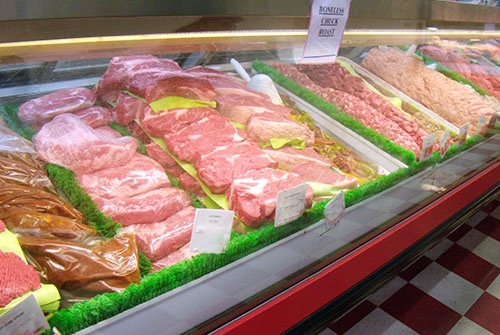Discover Fresh Cuts at Bagley Farms Meat Market Edwardsville IL for Your Following BBQ
Discover Fresh Cuts at Bagley Farms Meat Market Edwardsville IL for Your Following BBQ
Blog Article
Reveal the Art of the Butcher's Cut in a Modern Meat Market
In the ever-evolving landscape of modern meat markets, the butcher's cut has actually transcended its traditional origins, merging old-time craftsmanship with modern methods. What truly sets the modern butcher apart is their capability to build a deeper link between customers and the beginnings of their meat.
Development of Butchery Strategies
The evolution of butchery strategies reflects an abundant tapestry of innovation and adaptation driven by innovations in innovation, adjustments in consumer need, and a much deeper understanding of meat science. Historically, butchery was a craft passed down via generations, with methods refined over centuries to optimize return and flavor. Nevertheless, the industrial change introduced mechanization, transforming typical practices and allowing massive handling.
The mid-20th century saw butchery methods better refined by scientific understandings right into muscular tissue biology and meat aging, boosting both inflammation and taste. Innovations like vacuum packaging and refrigeration prolonged product shelf-life, enabling butchers to branch out offerings and enhance quality assurance. This duration additionally noted the surge of specialized equipment, such as band saws and meat slicers, which boosted precision and effectiveness in meat processing.

The 21st century has actually presented digital innovation into the butchery realm. Digital systems currently assist in monitoring pet provenance and enhancing cuts to satisfy particular customer choices. In addition, a rebirth in artisanal butchery has actually emerged, mixing conventional skills with modern-day expertise to satisfy consumers looking for moral and lasting meat choices. This evolution underscores a dynamic interaction in between custom and development, meeting modern needs while maintaining the craft's heritage.
Recognizing Meat Cuts
Recognizing the intricacies of meat cuts is necessary for both butchers and customers looking for high quality and worth. For butchers, precise cuts show ability and regard for the craft, ensuring minimal waste and ideal return.

Understanding muscle mass make-up is critical; muscles used much more frequently by the pet often tend to be tougher and are best matched for slow food preparation methods, while less-used muscular tissues, like those discovered in the loin, are more tender and perfect for barbecuing or roasting. Familiarity with these differences empowers customers to make informed selections, improving their cooking undertakings.
Selecting Top Quality Meat
Choosing the best meat entails more than just choosing an aesthetically appealing piece from the screen. The art of choosing quality meat requires a critical eye and expertise of particular characteristics that symbolize quality and quality.
Second of all, consider the marbling, which refers to the white flecks of fat within the muscle. Proper marbling is an essential sign of inflammation and taste, as it thaws throughout food preparation, improving the meat's juiciness. Bear in mind, greater marbling often correlates with premium quality cuts, such as USDA Prime.
Texture is another vital aspect; meat must really feel solid to the touch, not slimed or extremely soft. Furthermore, bear in mind the scent. Fresh meat should have a clean, neutral scent, free from any sour or off-putting smells.
Coupling Cuts With Food Preparation Techniques

Alternatively, harder cuts like brisket and chuck roast are rich in collagen, which breaks down into gelatin when cooked gradually. These cuts are excellent for braising or slow roasting, allowing the meat to tenderize gradually and establish deep, intricate tastes. In a similar way, cuts such as brief ribs and pork shoulder fare well with slow-cooking methods, where extended cooking times transform their robust textures into succulent meals.
Lamb shanks and oxtail, which call for long term food preparation to soften, are excellent prospects for cooking or slow-moving simmering. These approaches coax out abundant, passionate tastes while keeping dampness. By recognizing the one-of-a-kind features of each cut, cooks and home chefs alike can raise their culinary developments, making sure each meal is both satisfying and memorable.
The Butcher's Role Today
Browsing the developing landscape of the modern meat market, the butcher's duty today prolongs beyond plain preparation of cuts. Contemporary butchers are cooking artisans, educators, and supporters for sustainable techniques. They connect the void between the ranch and the fork by making sure ethical sourcing, recognizing animal husbandry, and prioritizing openness in the supply chain. This shift reflects the expanding consumer need for top quality over amount, where provenance and like this animal well-being are vital.
In addition to crafting exact cuts, butchers now involve directly with consumers, supplying cooking recommendations and customizing selections to fit specific demands and preferences. Their expertise in meat aging, marbling, and flavor accounts encourages consumers to make informed decisions, boosting their cooking experiences. This individualized solution exemplifies the butcher's developing function as a relied on advisor in the kitchen area.
In addition, butchers are pivotal in lessening waste, making Continue use of whole animals to create varied items such as sausages and supplies. This extensive method not just values the pet but also aligns with contemporary sustainability goals. By doing this, the modern-day butcher personifies both tradition and development, adjusting to an ever-changing market while preserving the virtuosity and honesty of their craft.
Verdict
Mastery in understanding diverse meat cuts and quality indications encourages butchers to supply educated suggestions, straightening specific cuts with optimal food preparation approaches. By honoring historical techniques while accepting contemporary needs, the butcher's function remains vital in today's innovative meat market.
Report this page